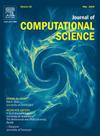Automatic learning analysis of flow-induced birefringence in cellulose nanofibrils
IF 3.1
3区 计算机科学
Q2 COMPUTER SCIENCE, INTERDISCIPLINARY APPLICATIONS
引用次数: 0
Abstract
Cellulose Nanofibrils (CNFs), highly present in nature, can be used as building blocks for future sustainable materials, including strong and stiff filaments. A rheo-optical flow-stop technique is used to conduct experiments to characterize the CNFs by studying Brownian dynamics through the CNFs’ birefringence decay after stop. As the experiments produce large quantities of data, we reduce their dimensionality using Principal Component Analysis (PCA) and exploit the possibility of visualizing the reduced data in two ways. First, we plot the principal components (PCs) as time series, and by training LSTM networks assigned for each PC time series with the data before the flow stop, we predict the behavior after the flow stop (Bragone et al., 2024). Second, we plot the first PCs against each other to create clusters that give information about the different CNF materials and concentrations. Our approach aims at classifying the CNF materials to varying concentrations by applying unsupervised machine learning algorithms, such as k-means and Gaussian Mixture Models (GMMs). Finally, we analyze the Autocorrelation Function (ACF) and the Partial Autocorrelation Function (PACF) of the first principal component, detecting seasonality in lower concentrations.
纤维素纳米原纤维流动诱导双折射的自动学习分析
纤维素纳米原纤维(CNFs)在自然界中高度存在,可以用作未来可持续材料的基石,包括坚固和坚硬的长丝。利用流变光流停止技术,通过研究CNFs在停止后双折射衰减的布朗动力学特性,对CNFs进行了表征实验。由于实验产生大量数据,我们使用主成分分析(PCA)对其进行降维,并利用两种方式对降维后的数据进行可视化。首先,我们将主成分(PC)绘制为时间序列,并通过使用流停止前的数据训练分配给每个PC时间序列的LSTM网络,我们预测流停止后的行为(Bragone等人,2024)。其次,我们将第一批pc相互对照,创建集群,提供有关不同CNF材料和浓度的信息。我们的方法旨在通过应用无监督机器学习算法,如k-means和高斯混合模型(gmm),对CNF材料进行不同浓度的分类。最后,我们分析了第一主成分的自相关函数(ACF)和部分自相关函数(PACF),以检测低浓度下的季节性。
本文章由计算机程序翻译,如有差异,请以英文原文为准。
求助全文
约1分钟内获得全文
求助全文
来源期刊

Journal of Computational Science
COMPUTER SCIENCE, INTERDISCIPLINARY APPLICATIONS-COMPUTER SCIENCE, THEORY & METHODS
CiteScore
5.50
自引率
3.00%
发文量
227
审稿时长
41 days
期刊介绍:
Computational Science is a rapidly growing multi- and interdisciplinary field that uses advanced computing and data analysis to understand and solve complex problems. It has reached a level of predictive capability that now firmly complements the traditional pillars of experimentation and theory.
The recent advances in experimental techniques such as detectors, on-line sensor networks and high-resolution imaging techniques, have opened up new windows into physical and biological processes at many levels of detail. The resulting data explosion allows for detailed data driven modeling and simulation.
This new discipline in science combines computational thinking, modern computational methods, devices and collateral technologies to address problems far beyond the scope of traditional numerical methods.
Computational science typically unifies three distinct elements:
• Modeling, Algorithms and Simulations (e.g. numerical and non-numerical, discrete and continuous);
• Software developed to solve science (e.g., biological, physical, and social), engineering, medicine, and humanities problems;
• Computer and information science that develops and optimizes the advanced system hardware, software, networking, and data management components (e.g. problem solving environments).
 求助内容:
求助内容: 应助结果提醒方式:
应助结果提醒方式:


